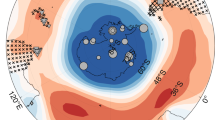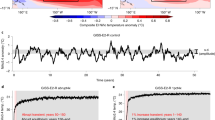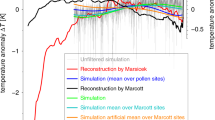Abstract
The Southern Annular Mode (SAM) is the primary pattern of climate variability in the Southern Hemisphere1,2, influencing latitudinal rainfall distribution and temperatures from the subtropics to Antarctica. The positive summer trend in the SAM over recent decades is widely attributed to stratospheric ozone depletion2; however, the brevity of observational records from Antarctica1—one of the core zones that defines SAM variability—limits our understanding of long-term SAM behaviour. Here we reconstruct annual mean changes in the SAM since AD 1000 using, for the first time, proxy records that encompass the full mid-latitude to polar domain across the Drake Passage sector. We find that the SAM has undergone a progressive shift towards its positive phase since the fifteenth century, causing cooling of the main Antarctic continent at the same time that the Antarctic Peninsula has warmed. The positive trend in the SAM since ∼AD 1940 is reproduced by multimodel climate simulations forced with rising greenhouse gas levels and later ozone depletion, and the long-term average SAM index is now at its highest level for at least the past 1,000 years. Reconstructed SAM trends before the twentieth century are more prominent than those in radiative-forcing climate experiments and may be associated with a teleconnected response to tropical Pacific climate. Our findings imply that predictions of further greenhouse-driven increases in the SAM over the coming century3 also need to account for the possibility of opposing effects from tropical Pacific climate changes.
This is a preview of subscription content, access via your institution
Access options
Subscribe to this journal
Receive 12 print issues and online access
$209.00 per year
only $17.42 per issue
Buy this article
- Purchase on Springer Link
- Instant access to full article PDF
Prices may be subject to local taxes which are calculated during checkout




Similar content being viewed by others
References
Marshall, G. J. Trends in the Southern Annular Mode from observations and reanalyses. J. Clim. 16, 4134–4143 (2003).
Thompson, D. W. J. et al. Signatures of the Antarctic ozone hole in Southern Hemisphere surface climate change. Nature Geosci. 4, 741–749 (2011).
Gillett, N. P. & Fyfe, J. C. Annular mode changes in the CMIP5 simulations. Geophys. Res. Lett. 40, 1189–1193 (2013).
Screen, J. A. & Simmonds, I. The central role of diminishing sea ice in recent Arctic temperature amplification. Nature 464, 1334–1337 (2010).
PAGES 2k consortium Continental-scale temperature variability during the past two millennia. Nature Geosci. 6, 339–346 (2013).
Bromwich, D. H. et al. Central west Antarctica among the most rapidly warming regions on Earth. Nature Geosci. 6, 139–144 (2013).
Mulvaney, R. et al. Recent Antarctic Peninsula warming relative to Holocene climate and ice-shelf history. Nature 489, 141–144 (2012).
Abram, N. J., Mulvaney, R. & Arrowsmith, C. Environmental signals in a highly resolved ice core from James Ross Island, Antarctica. J. Geophys. Res. 116, D20116 (2011).
Abram, N. J. et al. Acceleration of snow melt in an Antarctic Peninsula ice core during the twentieth century. Nature Geosci. 6, 404–411 (2013).
Fogt, R. L. et al. Historical SAM variability part II: Twentieth-century variability and trends from reconstructions, observations, and the IPCC AR4 models. J. Clim. 22, 5346–5365 (2009).
Jones, P. D. et al. High-resolution palaeoclimatology of the last millennium: A review of current status and future prospects. The Holocene 19, 3–49 (2009).
Hegerl, G. C. et al. Detection of human influence on a new, validated 1,500-year temperature reconstruction. J. Clim. 20, 650–666 (2007).
Ding, Q. H., Steig, E. J., Battisti, D. S. & Wallace, J. M. Influence of the tropics on the Southern Annular Mode. J. Clim. 25, 6330–6348 (2012).
Fogt, R. L., Jones, J. M. & Renwick, J. Seasonal zonal asymmetries in the Southern Annular Mode and their impact on regional temperature anomalies. J. Clim. 25, 6253–6270 (2012).
Fogt, R. L., Bromwich, D. H. & Hines, K. M. Understanding the SAM influence on the South Pacific ENSO teleconnection. Clim. Dynam. 36, 1555–1576 (2011).
Dee, D. P. et al. The ERA-Interim reanalysis: Configuration and performance of the data assimilation system. Q. J. R. Meteorol. Soc. 137, 553–597 (2011).
Goodwin, I. et al. A reconstruction of extratropical Indo–Pacific sea-level pressure patterns during the Medieval Climate Anomaly. Clim. Dynam. http://dx.doi.org/doi:10.1007/s00382-013-1899-1 (2013).
Villalba, R. et al. Unusual Southern Hemisphere tree growth patterns induced by changes in the Southern Annular Mode. Nature Geosci. 5, 793–798 (2012).
Goodwin, I. D., van Ommen, T. D., Curran, M. A. J. & Mayewski, P. A. Mid latitude winter climate variability in the south Indian and southwest Pacific regions since AD 1300. Clim. Dynam. 22, 783–794 (2004).
Christie, D. A. et al. Aridity changes in the temperate-Mediterranean transition of the Andes since AD 1346 reconstructed from tree-rings. Clim. Dynam. 36, 1505–1521 (2011).
Taylor, K. E., Stouffer, R. J. & Meehl, G. A. An overview of CMIP5 and the experiment design. Bull. Am. Meteorol. Soc. 93, 485–498 (2012).
Schmidt, G. A. et al. Climate forcing reconstructions for use in PMIP simulations of the last millennium (v10). Geosci. Model Dev. 4, 33–45 (2011).
Phipps, S. J. et al. Paleoclimate data-model comparison and the role of climate forcings over the past 1,500 years. J. Clim. 26, 6915–6936 (2013).
Shapiro, A. I. et al. A new approach to the long-term reconstruction of the solar irradiance leads to large historical solar forcing. Astron. Astrophys. 529, A67 (2011).
Schmidt, G. A. et al. Climate forcing reconstructions for use in PMIP simulations of the last millennium (v11). Geosci. Model Dev. 5, 185–191 (2012).
Emile-Geay, J., Cobb, K. M., Mann, M. E. & Wittenberg, A. T. Estimating central equatorial Pacific SST variability over the past millennium part II: Reconstructions and implications. J. Clim. 26, 2329–2352 (2013).
Wang, G. J. & Cai, W. J. Climate-change impact on the 20th-century relationship between the Southern Annular Mode and global mean temperature. Sci. Rep. 3, 2039 (2013).
Barrand, N. E. et al. Trends in Antarctic Peninsula surface melting conditions from observations and regional climate modelling. J. Geophys. Res. 118, 315–330 (2013).
Cai, W. et al. Increasing frequency of extreme El Niño events due to greenhouse warming. Nature Clim. Change 4, 111–116 (2014).
Reynolds, R. W., Rayner, N. A., Smith, T. M., Stokes, D. C. & Wang, W. An improved in situ and satellite SST analysis for climate. J. Clim. 15, 1609–1625 (2002).
Acknowledgements
N.J.A. is supported by a Queen Elizabeth II fellowship awarded by the Australian Research Council (ARC DP110101161). This study contributes to ARC Discovery Project DP140102059 awarded to N.J.A. and R.M. and is part of the British Antarctic Survey’s Polar Science for Planet Earth programme financially supported by the Natural Environment Research Council. Modelling work using CSIRO Mk3L was supported by an award to S.J.P. of computational resources on the NCI National Facility through the National Computational Merit Allocation Scheme. M.H.E. is supported by ARC Laureate Fellowship FL100100214. We thank E. Wolff for discussions that improved the paper and we gratefully acknowledge the efforts of the PAGES2k and CMIP5/PMIP3 communities in archiving the proxy synthesis and model products that were used in this study.
Author information
Authors and Affiliations
Contributions
N.J.A. conceived the study and carried out the data analysis, with support from the other authors. All authors contributed to the discussion of ideas and writing of the paper.
Corresponding author
Ethics declarations
Competing interests
The authors declare no competing financial interests.
Supplementary information
Rights and permissions
About this article
Cite this article
Abram, N., Mulvaney, R., Vimeux, F. et al. Evolution of the Southern Annular Mode during the past millennium. Nature Clim Change 4, 564–569 (2014). https://doi.org/10.1038/nclimate2235
Received:
Accepted:
Published:
Issue Date:
DOI: https://doi.org/10.1038/nclimate2235
This article is cited by
-
Noble gas evidence of a millennial-scale deep North Pacific palaeo-barometric anomaly
Nature Geoscience (2024)
-
Evaluation of trends and analysis of air temperature and wind on the Antarctic Peninsula using extreme value theory
Theoretical and Applied Climatology (2024)
-
A 1500-year record of mercury isotopes in seal feces documents sea ice changes in the Antarctic
Communications Earth & Environment (2023)
-
Trends and variability in the Southern Annular Mode over the Common Era
Nature Communications (2023)
-
Climate variability a key driver of recent Antarctic ice-mass change
Nature Geoscience (2023)



